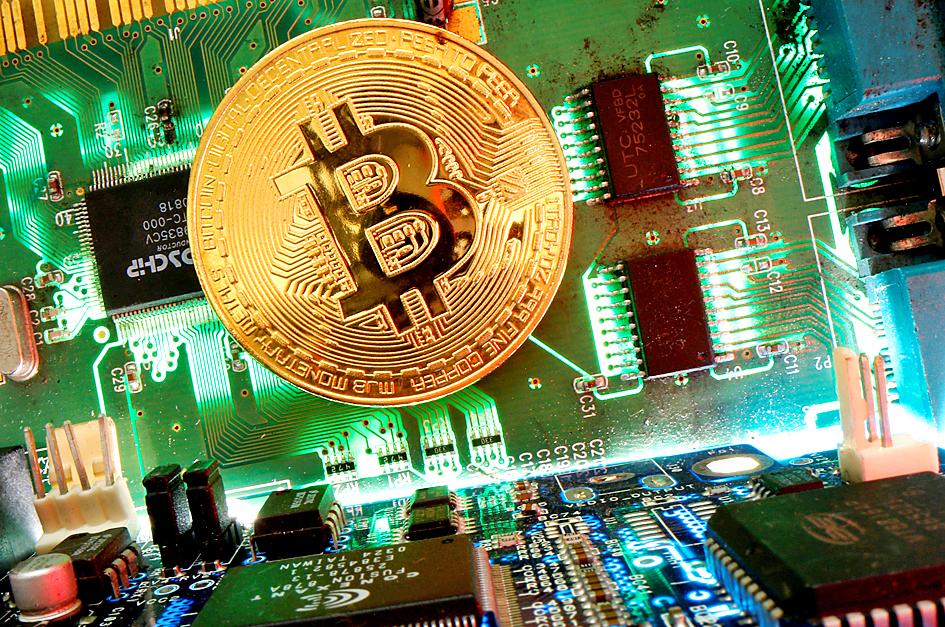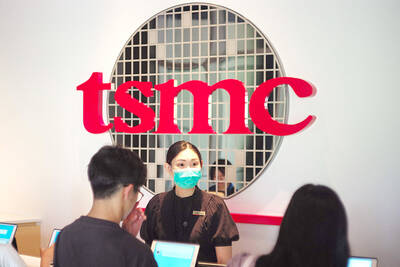Bitcoin yesterday slid after a bout of volatility highlighted lingering doubts about the durability of its mesmerizing rally.
The cryptocurrency fell as much as 12.5 percent to US$48,071 and was trading below US$50,000 as of 8:16am in London. At one point on Monday it plunged 17 percent before paring the slide. Bitcoin is still up about 390 percent in the past year.
US Secretary of the Treasury Janet Yellen and Microsoft Corp cofounder Bill Gates were the latest to weigh into a debate over the digital coin.

Photo: Reuters
Gates cautioned about how investors can be swept up in manias, while Yellen said bitcoin is a very “inefficient” way of conducting transactions.
In the background are jitters that the global economic recovery from the COVID-19 pandemic would eventually prompt central banks to dial back easy-money policies that helped propel bitcoin higher.
At a technical level, the digital currency looks stretched, Miller Tabak and Co has said.
A monthly relative strength index for bitcoin is “extremely overbought,” the company’s chief market strategist Matt Maley wrote in a note over the weekend.
Gates and Yellen muscled in on a discussion that of late had been dominated by Tesla Inc chief executive officer Elon Musk. He has tweeted that bitcoin prices “seem high,” but also that the token is a “less dumb” version of cash.
Bitcoin faithful argue that the digital currency is a hedge for risks such as faster inflation and is winning more attention from corporate treasurers and long-term investors. Others see echoes of the digital coin’s 2017 boom and bust.
“It’s a pure speculative asset,” said Nader Naeimi, head of dynamic markets at AMP Capital Investors in Sydney.
The Bloomberg Galaxy Crypto Index, which spans bitcoin, ether and three other digital tokens, declined as much as 13 percent.

Taiwan Transport and Storage Corp (TTS, 台灣通運倉儲) yesterday unveiled its first electric tractor unit — manufactured by Volvo Trucks — in a ceremony in Taipei, and said the unit would soon be used to transport cement produced by Taiwan Cement Corp (TCC, 台灣水泥). Both TTS and TCC belong to TCC International Holdings Ltd (台泥國際集團). With the electric tractor unit, the Taipei-based cement firm would become the first in Taiwan to use electric vehicles to transport construction materials. TTS chairman Koo Kung-yi (辜公怡), Volvo Trucks vice president of sales and marketing Johan Selven, TCC president Roman Cheng (程耀輝) and Taikoo Motors Group

Among the rows of vibrators, rubber torsos and leather harnesses at a Chinese sex toys exhibition in Shanghai this weekend, the beginnings of an artificial intelligence (AI)-driven shift in the industry quietly pulsed. China manufactures about 70 percent of the world’s sex toys, most of it the “hardware” on display at the fair — whether that be technicolor tentacled dildos or hyper-realistic personalized silicone dolls. Yet smart toys have been rising in popularity for some time. Many major European and US brands already offer tech-enhanced products that can enable long-distance love, monitor well-being and even bring people one step closer to

RECORD-BREAKING: TSMC’s net profit last quarter beat market expectations by expanding 8.9% and it was the best first-quarter profit in the chipmaker’s history Taiwan Semiconductor Manufacturing Co (TSMC, 台積電), which counts Nvidia Corp as a key customer, yesterday said that artificial intelligence (AI) server chip revenue is set to more than double this year from last year amid rising demand. The chipmaker expects the growth momentum to continue in the next five years with an annual compound growth rate of 50 percent, TSMC chief executive officer C.C. Wei (魏哲家) told investors yesterday. By 2028, AI chips’ contribution to revenue would climb to about 20 percent from a percentage in the low teens, Wei said. “Almost all the AI innovators are working with TSMC to address the

Malaysia’s leader yesterday announced plans to build a massive semiconductor design park, aiming to boost the Southeast Asian nation’s role in the global chip industry. A prominent player in the semiconductor industry for decades, Malaysia accounts for an estimated 13 percent of global back-end manufacturing, according to German tech giant Bosch. Now it wants to go beyond production and emerge as a chip design powerhouse too, Malaysian Prime Minister Anwar Ibrahim said. “I am pleased to announce the largest IC (integrated circuit) Design Park in Southeast Asia, that will house world-class anchor tenants and collaborate with global companies such as Arm [Holdings PLC],”